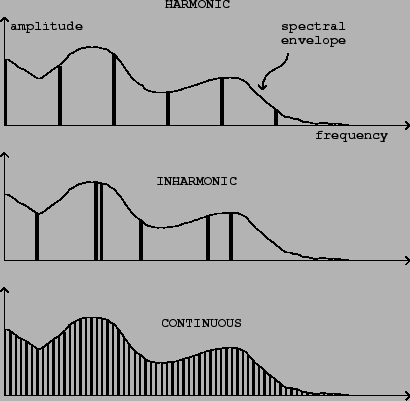The FOURIER SERIES (page ![]() ) gives a description of
a periodic signal as a sum of sinusoids. The frequencies of the sinusoids
are in the ratio
) gives a description of
a periodic signal as a sum of sinusoids. The frequencies of the sinusoids
are in the ratio ![]() . (The constant term in the Fourier series
may be thought of as a sinusoid,
. (The constant term in the Fourier series
may be thought of as a sinusoid,
The top of Figure 5.1 shows the spectrum of a periodic signal. The spectrum shows how the signal's power is distributed into frequencies. (This isn't a real mathematical definition; to provide one would require a background in functional analysis.)
In the case of the periodic signal, the power shown in the spectrum is
concentrated on a discrete subset of the frequency axis (a discrete
set consists of isolated points, only finitely many per unit). We call
this a
discrete spectrum. Furthermore, the spectrum is called
harmonic, meaning that the frequencies where the signal's power lies
are in the ![]() ratio that arises from a periodic signal. (Note
that it's not necessary for all of the harmonic frequencies to be
present; some harmonics may have zero amplitude.) We'll only consider a signal
to be harmonic if the fundamental frequency is in the range of perceptible
pitches, roughly between 50 and 4000 Hz.
ratio that arises from a periodic signal. (Note
that it's not necessary for all of the harmonic frequencies to be
present; some harmonics may have zero amplitude.) We'll only consider a signal
to be harmonic if the fundamental frequency is in the range of perceptible
pitches, roughly between 50 and 4000 Hz.
 |
The graph of the spectrum shows the amplitudes of the partials of the signals. Knowing the amplitudes and phases of all the partials would allow us to reconstruct the original signal.
The second spectrum pictured in the figure is also discrete, and so the signal can again be considered as a sum of a series of partials. In this case, however, there is no fundamental frequency, i.e., no common submultiple of all the partials. We call this an inharmonic spectrum.
In dealing with discrete spectra, we adopt a convention whose purpose will
only become clear gradually: each component sinusoid,
Finally, the bottom of the figure shows a third possibility, which is that the spectrum might not be concentrated into a discrete set of frequencies, but might be spread out among all possible frequencies. This can be called a continuous, or noisy spectrum. Spectra don't have to fall into either the discrete or continuous categories; they may be mixtures of the two.
Each of the three spectra in the figure shows a continuous curve called the spectral envelope. In general, sounds don't have a single, well-defined spectral envelope; there may be many ways to draw a smooth-looking curve through a spectrum. On the other hand, a spectral envelope may be specified intentionally by an electronic musician. In that case, it is usually clear how to make a spectrum conform to the specified spectral envelope. For a discrete spectrum, for example, we could simply read off, from the spectral envelope, the desired amplitude of each partial and make it so.
We have been speaking of spectra here as static entities, not considering whether they change in time or not. A spectrum can be thought of as representing the momentary pitch and timbre of an audio signal.
For discrete spectra, the pitch is primarily encoded in the frequencies of the partials. Harmonic signals have a pitch determined by their fundamental frequency; for inharmonic ones, the pitch may be clear, ambiguous, or absent altogether, according to complex and incompletely understood rules. A noisy spectrum may also have a perceptible pitch if the spectral envelope contains one or more narrow peaks.
In this model the timbre (and the loudness) are mostly encoded in the spectral envelope. The distinction between continuous and discrete spectra is also a distinction in timbre. The timbre, as well as the pitch, may evolve over the life of a sound.
This way of viewing sounds is greatly oversimplied. The true behavior of audible pitch and timbre boasts many features which can't be explained in terms of this model. For instance, the timbral quality called ``roughness" is sometimes thought of as being encoded in rapid changes in the spectral envelope over time. This model is useful nonetheless in discussions about how to construct discrete or continuous spectra for a wide variety of musical purposes, as we will begin to show in the rest of this chapter.